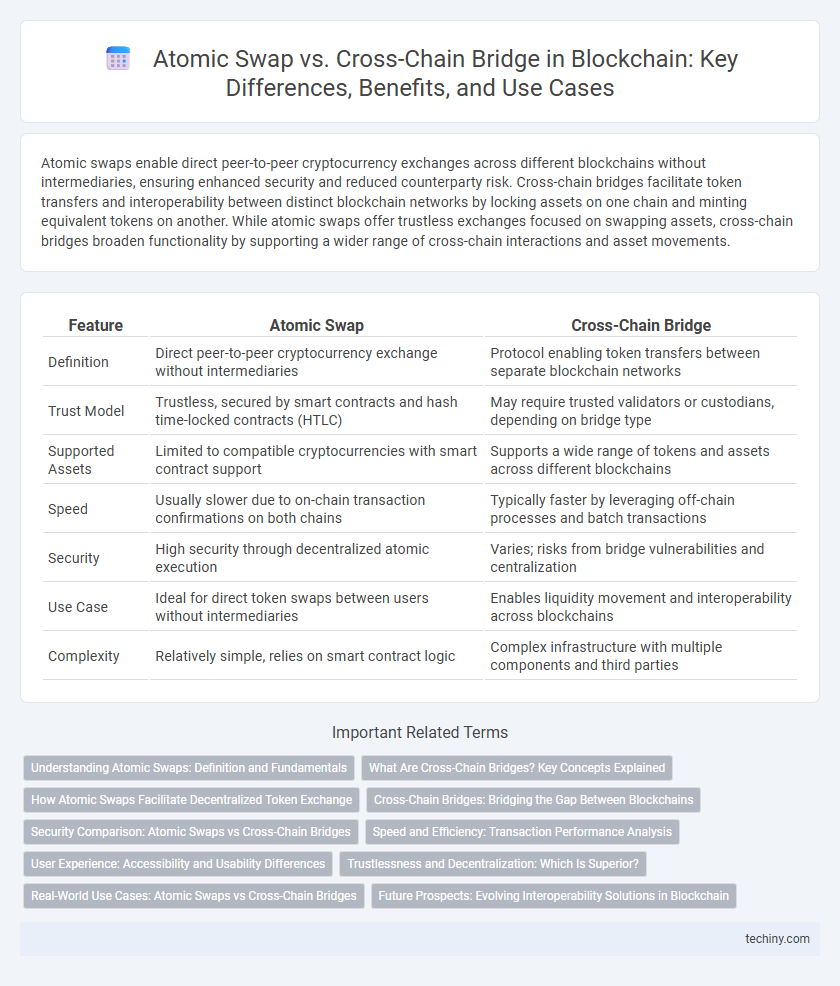Atomic swaps enable direct peer-to-peer cryptocurrency exchanges across different blockchains without intermediaries, ensuring enhanced security and reduced counterparty risk. Cross-chain bridges facilitate token transfers and interoperability between distinct blockchain networks by locking assets on one chain and minting equivalent tokens on another. While atomic swaps offer trustless exchanges focused on swapping assets, cross-chain bridges broaden functionality by supporting a wider range of cross-chain interactions and asset movements.
Table of Comparison
| Feature | Atomic Swap | Cross-Chain Bridge |
|---|---|---|
| Definition | Direct peer-to-peer cryptocurrency exchange without intermediaries | Protocol enabling token transfers between separate blockchain networks |
| Trust Model | Trustless, secured by smart contracts and hash time-locked contracts (HTLC) | May require trusted validators or custodians, depending on bridge type |
| Supported Assets | Limited to compatible cryptocurrencies with smart contract support | Supports a wide range of tokens and assets across different blockchains |
| Speed | Usually slower due to on-chain transaction confirmations on both chains | Typically faster by leveraging off-chain processes and batch transactions |
| Security | High security through decentralized atomic execution | Varies; risks from bridge vulnerabilities and centralization |
| Use Case | Ideal for direct token swaps between users without intermediaries | Enables liquidity movement and interoperability across blockchains |
| Complexity | Relatively simple, relies on smart contract logic | Complex infrastructure with multiple components and third parties |
Understanding Atomic Swaps: Definition and Fundamentals
Atomic swaps enable direct peer-to-peer cryptocurrency exchanges across different blockchains without relying on intermediaries, ensuring trustless and secure transactions. They operate through hashed time-locked contracts (HTLCs), which use cryptographic conditions to guarantee that either both parties fulfill the trade or the transaction is voided, preventing loss of funds. This mechanism contrasts with cross-chain bridges by providing enhanced security while eliminating counterparty risk and reducing centralization vulnerabilities.
What Are Cross-Chain Bridges? Key Concepts Explained
Cross-chain bridges enable interoperability between different blockchain networks by allowing the transfer of assets and data without intermediaries. They function through mechanisms like locking tokens on one chain while minting equivalent tokens on another, ensuring security and decentralization. These bridges facilitate seamless communication across ecosystems, expanding use cases and liquidity options in decentralized finance (DeFi).
How Atomic Swaps Facilitate Decentralized Token Exchange
Atomic swaps enable direct peer-to-peer trading of cryptocurrencies across different blockchains without relying on intermediaries, ensuring trustless and secure transactions through smart contract technology. These swaps utilize hash time-locked contracts (HTLCs) to guarantee that both parties simultaneously fulfill the exchange conditions or the transaction is voided, eliminating counterparty risk. Compared to cross-chain bridges, atomic swaps enhance decentralization by avoiding centralized validators, thereby reducing vulnerability to censorship and single points of failure.
Cross-Chain Bridges: Bridging the Gap Between Blockchains
Cross-chain bridges enable seamless interoperability by allowing assets and data to move across different blockchain networks without relying on centralized intermediaries. These bridges use smart contracts and consensus mechanisms to securely lock tokens on one chain and mint equivalents on another, maintaining trustless and decentralized transactions. Compared to atomic swaps that facilitate direct token exchanges between users, cross-chain bridges support more complex interactions and broader ecosystem integration.
Security Comparison: Atomic Swaps vs Cross-Chain Bridges
Atomic swaps offer heightened security by enabling peer-to-peer cryptocurrency exchanges without intermediaries, reducing vulnerabilities linked to centralized points of failure. Cross-chain bridges, while facilitating asset transfers across different blockchains, are prone to security risks such as smart contract exploits and custodial breaches. The trustless nature of atomic swaps generally provides a more secure mechanism compared to the complex and often more attack-surface-heavy architecture of cross-chain bridges.
Speed and Efficiency: Transaction Performance Analysis
Atomic swaps enable direct peer-to-peer exchanges between different blockchain assets without intermediaries, significantly reducing transaction time by eliminating reliance on third-party validators. Cross-chain bridges, while facilitating asset transfers across chains, often involve multiple validation layers and confirmations, leading to higher latency and reduced throughput. Evaluating transaction speed and efficiency, atomic swaps typically offer faster settlement and lower operational overhead compared to cross-chain bridges, which can experience bottlenecks due to their complex consensus mechanisms.
User Experience: Accessibility and Usability Differences
Atomic swaps enable direct peer-to-peer cryptocurrency exchanges without intermediaries, offering enhanced security but often require technical knowledge and compatible wallets, limiting accessibility for average users. Cross-chain bridges provide a more user-friendly interface by facilitating asset transfers across different blockchains through smart contracts, making usability more intuitive for non-expert users. However, bridges may introduce additional risks like smart contract vulnerabilities and longer transaction times, impacting overall user experience compared to atomic swaps.
Trustlessness and Decentralization: Which Is Superior?
Atomic swaps enable trustless peer-to-peer cryptocurrency exchanges directly between different blockchains without intermediaries, ensuring higher decentralization and security. Cross-chain bridges facilitate asset transfers by relying on validators or federations, which introduces centralized points of failure and trust assumptions. Therefore, atomic swaps outperform cross-chain bridges in trustlessness and decentralization, preserving the core principles of blockchain technology.
Real-World Use Cases: Atomic Swaps vs Cross-Chain Bridges
Atomic swaps enable direct peer-to-peer cryptocurrency exchanges across different blockchains without intermediaries, enhancing security and reducing fees in decentralized trading. Cross-chain bridges facilitate asset transfers and data interoperability between distinct blockchain networks, supporting use cases like DeFi liquidity pooling and multi-chain NFT ecosystems. Real-world applications of atomic swaps include trustless token trading on decentralized exchanges, while cross-chain bridges power cross-platform DeFi protocols and seamless asset migration.
Future Prospects: Evolving Interoperability Solutions in Blockchain
Atomic swaps leverage decentralized protocols to enable direct peer-to-peer exchanges of cryptocurrencies across different blockchains without intermediaries, enhancing security and trustlessness. Cross-chain bridges facilitate asset transfers and data communication between distinct blockchain networks by connecting their protocols, offering broader interoperability but often introducing centralized risks and smart contract vulnerabilities. Future prospects involve hybrid models combining the trustless nature of atomic swaps with the scalability and functionality of bridges, driven by advancements in cryptographic proofs and layer-2 solutions to achieve seamless, secure multi-chain ecosystems.
Atomic swap vs Cross-chain bridge Infographic

 techiny.com
techiny.com